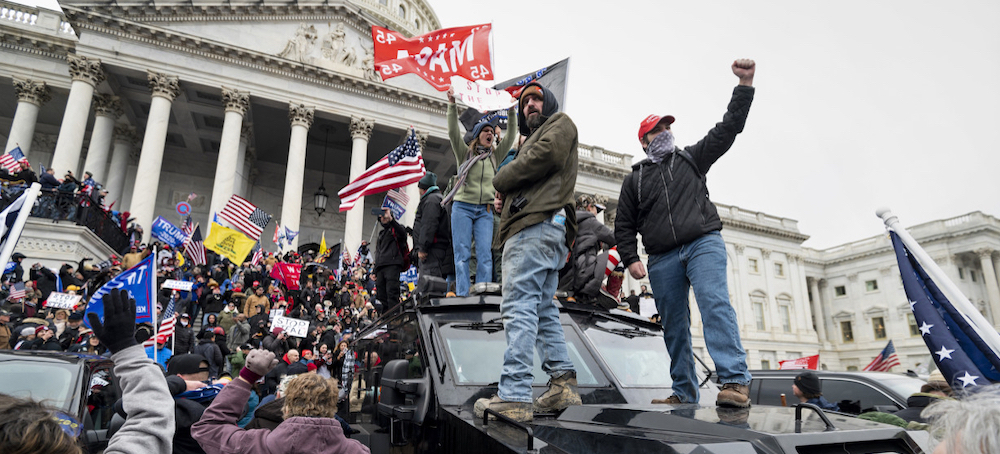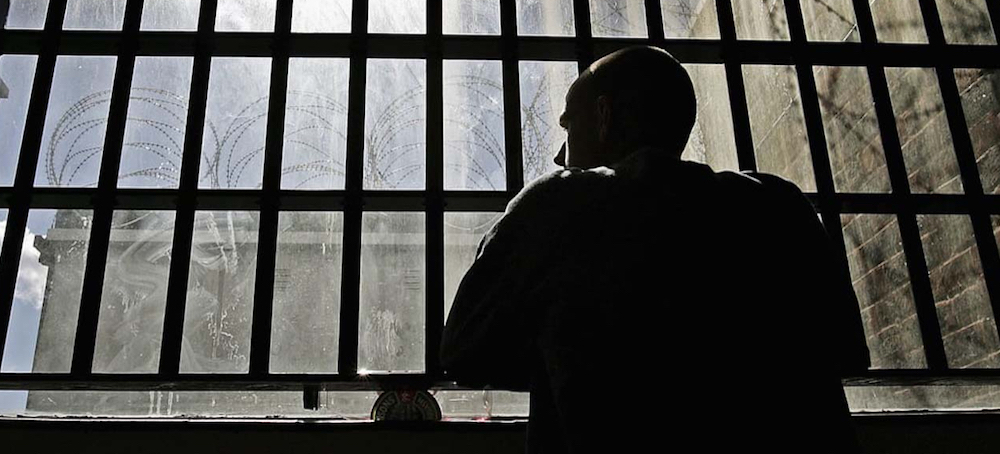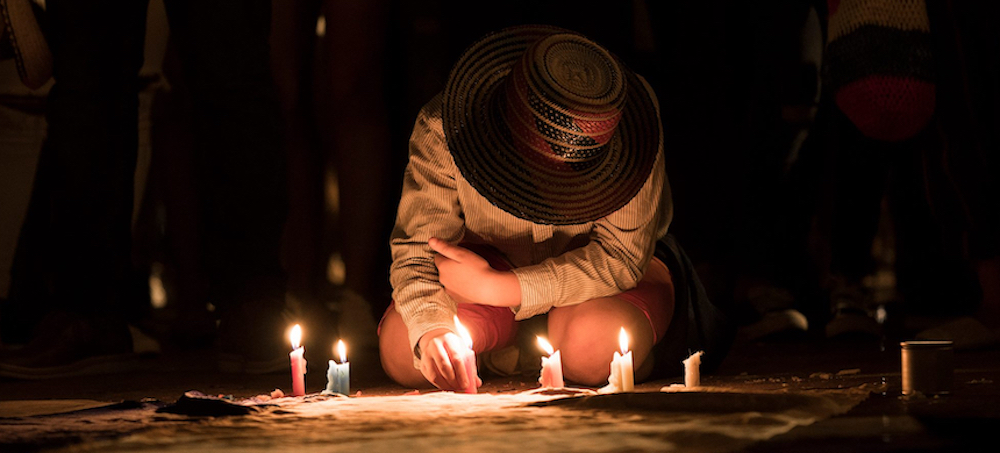Live on the homepage now!
Reader Supported News
Making sense of a swirling political climate
We often look at flags to give us tangible proof of the directional force of wind. But as you can see, the two Icelandic flags captured here convey contrasting circumstances. It’s a testimony to the physical realities of that beautiful wind-swept island. It’s also a useful note of caution that sometimes the answer to the question, “Which way is the wind blowing?” isn’t that simple.
The notion of the wind blowing in a single direction is often used as a metaphor for competition, especially in politics. We speak of “headwinds,” or which candidate has the “wind at their back.” And we try, through polling and supposition, to determine momentum and the force of support — once again, which way the wind is blowing.
Sometimes this is a useful lens through which to view a political environment. There can be times when the force of public opinion is so strong in a single direction that you have “wave elections” (many waves are caused by wind). But in reality all elections are competitions of forces pushing in different directions. Even the most popular candidates have their detractors. And the same qualities that might excite large swaths of the voting public for one politician invariably push other voters in the opposite direction.
I’ve been covering politics for 72 years (!), and in all that time there seldom if ever has been as complicated a political picture as what we have today. If you were to ask me, “Which way is the wind blowing?” I would respond with a simple but perhaps unsatisfying answer: everywhere.
By traditional metrics, the looming midterm elections would shape up to be a disaster for the Democratic Party, and indeed that is a possible outcome.
We have a level of inflation we haven’t seen in decades. And this is particularly visible at the gas pump, which means every time anyone passes a gas station they are reminded of the high prices (and people often drive by several gas stations through the course of a day).
We have a pandemic that is still making people sick, upending plans, and disrupting our economy, as well as the rest of the world’s — even though Americans want to pretend it is over.
Speaking of the world, we have uncertainty overseas, particularly a bloody war in Ukraine that further exacerbates our spiking energy prices and a general sense of foreboding and unease.
Even though Democrats hold the presidency and (nominally) both houses of Congress, there is a perception that the party has failed to deliver on many important promises. And this has led to the expected infighting between factions of the party over who is to blame. Many point fingers at those two recalcitrant senators whose names are linked in more news articles than Bonnie and Clyde. Joe Manchin’s and Kyrsten Sinema’s refusal to ditch the filibuster has led to paralysis in the Senate on key bills from voting rights to abortion rights.
All of this dissatisfaction has caused President Biden’s job approval ratings to drop so steeply you could fashion an Olympic downhill ski run on their decline. A recent New York Times poll suggests most Democrats don’t want Biden to run again.
Ordinarily, these factors would likely add up to gale-force winds blowing in the direction of Democrats getting walloped up and down the ballot this November.
But these times are different.
Because there’s a heckuva lot of wind blowing in the opposite direction.
First is the Supreme Court, where at least five justices are acting like their own little hurricanes (to continue to stretch the wind metaphor), tearing apart the structure of American law, public opinion be damned. Hurricane Thomas even wrote publicly what many expect — that they are nowhere near done after their rulings on abortion, guns, voting rights, and the environment. Gay marriage, contraception, the right to privacy — everything is in their sights, including perhaps the fair functioning of American democracy.
There is also the lingering shadow (or perhaps more apt, stench) of the previous administration. President Trump is even less popular than President Biden. In the same New York Times poll where Biden is polling in the low 30s, the current president is still beating the one he defeated in 2020. And with the investigation of the January 6 committee leading to more bombshells than a season of "The Sopranos" (and with the same mafia vibe), the horrors of the Trump cabal aren’t leaving the national consciousness anytime soon.
Add to this the fact that Republican voters have chosen many extremist candidates (often promoted by Trump) in primaries, and you have more proof that the party is doubling down in ways that are unpopular with the public at large.
All this adds up to, well, who exactly knows? That’s why we have elections.
Which way is the wind blowing?
Will voters beset by rising prices take it out on the "ruling" party?
Will the Supreme Court’s dive into the reactionary deep-end spur voters to show their disgust at the polls?
Will Democratic voters frustrated by a lack of action on big issues they care about stay home out of frustration?
Will candidates like Herschel Walker in Georgia and Mehmet Oz in New Jersey (I mean Pennsylvania) sink Republican hopes in the Senate?
Will apathy or anger be the driving narrative?
The answer to all of these questions is probably some version of yes and no. The swirling wind makes political prognostication particularly problematic. And there is plenty of time for the winds to shift again.
When the November elections are over, which way do you think the wind will have blown?
 Trump supporters stand on a Capitol Police armored vehicle as others take over the steps of the Capitol on Jan. 6, 2021. (photo: Bill Clark/CQ-Roll Call/Getty Images)
Trump supporters stand on a Capitol Police armored vehicle as others take over the steps of the Capitol on Jan. 6, 2021. (photo: Bill Clark/CQ-Roll Call/Getty Images)
The House committee asked that the agency submit the relevant records by Tuesday, ahead of a high-profile prime-time hearing on Thursday.
In a letter to Secret Service Director James Murray, Committee chair Bennie Thompson, D-Miss., said the panel wanted any pertinent text messages and other records tied to Jan. 6. He said the request was being made after the Department of Homeland Security's inspector general notified congressional committees of allegations that the Secret Service had erased text messages after the internal watchdog requested records of electronic communications surrounding the Jan. 6 riot.
Thompson's letter was sent after Homeland Security Inspector General Joseph Cuffari briefed all nine committee members Friday, a source familiar with the matter told NBC News.
Two days earlier, Cuffari said in a letter to two congressional committees he was informed that many of the messages from Jan. 6 and the day before the attack had been erased by the Secret Service “as part of a device-replacement program.” The letter he sent to the Senate Homeland Security and Governmental Affairs Committee and the House Homeland Security Committee was also given to the Jan. 6 committee.
Secret Service spokesman Anthony Guglielmi insisted in a statement Thursday that the agency has fully cooperated with the inspector general’s review and that some text messages were erased before they were requested. Guglielmi also said that the inspector general’s office had been notified of the data loss on some phones and confirmed that “none of the texts it was seeking had been lost in the migration.”
Thompson responded to Guglielmi's rebuttal by requesting the records in Friday's letter to Murray.
“Accordingly, the Select Committee seeks the relevant text messages, as well as any after action reports that have been issued in any and all divisions of the USSS pertaining or relating in any way to the events of January 6, 2021,” he wrote.
The rare public clash between the Jan. 6 committee and a federal agency comes as the panel prepares for a prime-time hearing Thursday where it is expected to provide new details about events tied to the insurrection.
The committee has asked that the agency submit the relevant records by Tuesday.
NBC News has reached out to the Secret Service for comment.
 From left, Rep. Rashida Tlaib, D-MI, Rep. llhan Omar, D-MN, Rep. Alexandria Ocasio-Cortez, D-NY, and Rep. Ayanna Pressley. (photo: J. Scott Applewhite/AP)
From left, Rep. Rashida Tlaib, D-MI, Rep. llhan Omar, D-MN, Rep. Alexandria Ocasio-Cortez, D-NY, and Rep. Ayanna Pressley. (photo: J. Scott Applewhite/AP)
Democrats are ramping up their messaging on abortion ahead of the midterms.
The action comes as Democrats ramp up their political messaging on abortion ahead of the November midterm elections, hoping the issue will drive voters to the ballot box to preserve the party's majorities in Congress.
"It's outrageous that 50 years later, women must again fight for our most basic rights against an extremist court and Republican Party," House Speaker Nancy Pelosi, D-Calif., said Friday in a press conference on the U.S. Capitol steps ahead of the vote.
"Democrats are honoring the basic truth: women's most intimate health decisions are her own," Pelosi added.
The first bill, titled the Women's Health Protection Act, would establish a statutory right for health care providers to provide, and patients to receive, abortion services. It would also prohibit states from imposing restrictions on abortion care.
The measure passed in a 219-to-210 vote. No Republicans voted in favor of the bill.
The Women's Health Protection Act now goes to the Senate, where it previously failed to move forward after the House first passed it in September 2021.
Any abortion-related legislation will likely meet a similar fate in the upper chamber, where Democrats need 10 Republican votes to overcome the 60-vote filibuster.
"We must ensure that the American people remember in November, because with two more Democratic senators, we will be able to eliminate the filibuster when it comes to a woman's right to choose and to make reproductive freedom the law of the land," Pelosi said Friday.
The second bill to pass the House, known as the Ensuring Access to Abortion Act, addresses recent efforts by state legislatures to punish Americans traveling for reproductive health care. The bill would would ensure no person acting under state law could prevent, restrict, or otherwise retaliate against a person traveling across state lines for lawful abortion services.
The measure passed 223 to 205.
Senate Republicans on Thursday blocked a bill that would have both legally shielded the people who travel across states lines to receive an abortion and the providers who care for those patients.
At least 13 states have ceased nearly all abortion services after the high court's June 24 decision ending Roe, and several Republican-controlled states are already considering legislation to bar women from seeking services out-of-state.
"Are we going to allow these lawmakers to hold American citizens hostage in their own states, forcing them to give birth?" Senate Majority Whip Dick Durbin, D-Ill., said in a floor speech on Thursday. "Does that sound like the America that we know? No it doesn't, and we need to draw the line here and now."
Just last week, hundreds of abortion rights activists protested outside the White House calling on President Joe Biden to do more to ensure abortion rights. Biden signed an executive order on July 8 aimed at protecting access, but said it's ultimately up to Congress to codify Roe.
Biden's message to the demonstrators was to "keep protesting."
"Keep making your point. It's critically important," he said.
 A prisoner. (photo: Peter Macdiarmid/Getty Images)
A prisoner. (photo: Peter Macdiarmid/Getty Images)
Buryak, the son of a high-ranking Ukrainian government official, was kidnapped by Russian soldiers as he tried to escape his hometown of Melitopol in early April. His case became one of thousands: The growing but impossible to track toll of abducted or forcefully disappeared Ukrainian civilians.
But his story is different from most. Vlad came home.
His improbable release offers a beam of hope during a dark time. With the war in its 20th week, bitter fighting continues along the front lines in Ukraine’s east. Russian rocket attacks kill more civilians each day, Ukrainian officials say, and allegations of atrocities have piled up. Many of the disappeared thousands never reappear, representing a special challenge for war crimes investigators.
Vlad’s case opens a rare window onto the experience of the legion of Ukrainians still detained in Russian-occupied territory, in facilities inaccessible to international rights monitors or independent journalists. In an interview with The Washington Post shortly after his safe return, the teen recounted the 90-day saga for the first time in an English-language publication.
According to Vlad and his father, Oleg Buryak, Russian troops took Vlad to a prison in Vasylivka, a city in the occupied part of Zaporizhzia province in the country’s southeast. For the first few days, they kept him in solitary confinement, he said.
Sitting in his prison cell, Vlad could not make sense of what has happening. “Why am I in this place, and when will I return back home?” he thought.
But the initial shock quickly turned into pure terror.
Less than a week after he arrived at the prison, Vlad said a man in his early 20s was moved into the same cell. He heard the young man being beaten and electrocuted, the torture sometimes lasting up to three hours at a time, he said.
Soon, the man said he could no longer bear it. He would rather “leave this earth than keep being tortured,” he told Vlad. He had a final wish: for Vlad to tell his story.
Vlad said the man then reached for the lid of a tin can and cut his wrists.
The teenager sat by his side, holding his hand as he slowly drifted away. But before he took his last breath, Vlad said, a guard came and called a medic, who took him away.
Vlad never found out whether the man, who said he had a wife and a child, survived.
The Post was not able to independently verify Vlad’s account. But Ukrainian human rights groups tracking forced disappearances said Vlad’s testimony is in line with that of other victims who have been released, and they said torture is “common practice.” The United Nations has also reported numerous cases of Russian soldiers torturing civilian and military prisoners.
And U.S. officials this week accused Russian forces of forcibly detaining or disappearing thousands of Ukrainian civilians, and said many of them are tortured.
Russia has repeatedly denied any claims of torture or other war crimes.
After the horrific episode, Vlad, alone in his cell, felt isolated again.
To pass time, he filled his days with menial tasks, preparing his own food, reading and sleeping. He said he was also forced to clean the room where other prisoners were tortured, where he would often find medical supplies that were soaked in blood, an endeavor he carried out with a pragmatic, almost militaristic mind-set.
“I had no emotions,” he said. “I have bottled them all up. I was acting like nothing had happened. I showed no aggression, so they won’t do the same thing with me.”
No matter the horror he witnessed — along with beatings and electroshocks, prisoners had needles pushed under their nails — Vlad remained detached.
“I understood that at that moment, I was also saving myself,” he added.
But inside: “I was extremely scared. I was shocked. Like everything inside me was burned down.”
Some moments were too jarring to process. One day, for instance, he said he entered the torture room and found a man hanging from the ceiling, his hands tied down with cables. A Russian soldier sat near the severely beaten-up prisoner, and, seemingly unfazed, took notes.
At home, Vlad’s father was engaged in a frantic, detective-like pursuit of his son. As head of the Zaporizhzhia Regional Military Administration, Oleg Buryak leaned on his government connections, desperate to set up a prisoner swap. Nothing was working.
After nearly seven weeks in the Russian prison, Vlad was transferred to a facility with better conditions, where he could bathe regularly and call his father.
Unsure if he would ever see him again, Vlad kept repeating two phrases, like a mantra.
There are no situations that cannot be solved.
I will get out.
On July 4, Buryak took a call from a Russian negotiator, who told him he was ready to set Vlad free. There are some details of the delicate exchange that Buryak said he could not disclose; some, he said he still does not understand. Vlad would be part of a three-person prisoner exchange, he said, and he’d be transferred back to Ukrainian territory in a civilian evacuation caravan.
Two days later, Vlad called his father.
“Dad, they’re saying I’m coming to you tomorrow.”
The final few hours were agonizing for father and son.
Buryak greeted Vlad on the side of a road, near line zero, where Ukrainian and occupied territory converge. Clad in camouflage body armor and blue jeans, Buryak flagged down a van. Vlad stepped out of the side door, and the two embraced. Finally.
Buryak rested his forehead on his son’s shoulder while he held him. His police escort had to remind him that they were standing in a war zone: “Oleg, let’s go,” they said. “Let’s go, let’s go.”
“When Vlad was kidnapped, it felt like a piece of my heart was torn away from me,” Buryak said. “And when I hugged him, I felt like that piece came back.”
But the country is still at war. The trauma of Vlad’s confinement will linger long after his release. The sounds of torture, the fear of being taken again and the smell of the blood-soaked cleaning rag have kept him awake and on edge. He said he feels at least five years older.
In an interview less than a week after his return, Vlad adopted the same stoic, determined manner as his father. He said he now spends his days volunteering for the war effort, handing out humanitarian aid and sharing his story. His jaw set, he said he wants to continue reliving what he saw, even the worst parts.
“I don’t want to forget any of that,” he said, “so I can tell others and make sure people know.”
 A Starbucks barista. (photo: USA TODAY)
A Starbucks barista. (photo: USA TODAY)
The coffee chain has announced it’s closing 16 stores, including some that have recently unionized. Workers say it’s coercion against labor organizing.
The coffee chain said that by the end of the month it would close six stores each in the Seattle and Los Angeles areas, two in Portland, Oregon, as well as locations in Washington, D.C. and Philadelphia. On Wednesday, Seattle workers from Starbucks Workers United (SBWU) — the union that has been organizing stores across the country — filed an unfair labor practice charge arguing that the closures amount to retaliation and illegal coercion against union activity.
Of the 16 stores set for closure, two locations in Seattle have successfully unionized and one store in Portland is set for a union vote in August.
“Within the past six months the Employer closed and/ or threatened to close at least 16 stores in order to discourage union activity, retaliate against workers engaged in union activity and/ or escape its obligation to bargain with the Union,” reads the complaint.
The charge seeks injunctive relief for the workers at the closed stores, which would fast-track a court order while the case is being litigated before the National Labor Relations Board (NLRB), a process which can often take months.
This isn’t the first time SBWU has charged that the company has shut down stores as a way to suppress organizing.
In May, the NLRB issued a wide-reaching complaint on behalf of unionized stores in the Buffalo, New York area that alleged upper management closed two stores shortly after the union drive began, an allegation that was among a list of over 200 labor violations. A federal court is currently holding a hearing on whether to issue injunctive relief based on that complaint.
Workers at a Starbucks store in Ithaca, New York filed a similar charge after the location was closed down at the beginning of June — two months after they voted to unionize.
In two letters that Starbucks executives sent to employees on Monday, management wrote that the changes, including store closures, are a part of a campaign to modernize in order to reflect the “state of the world, the conditions of our stores and communities, and the hopes and dreams and lives of each of our partners.”
Part of that effort, the letters said, includes addressing incidents that involve mental health crises, drug use and racism that workers encounter on the job. Debbie Stroud and Denise Nelson, senior vice presidents of U.S. operations, wrote that remedies for such incidents can include modifying hours, closing a restroom or even closing a store permanently.
In a statement to In These Times on the initiative, a Starbucks spokesperson said: “We’re empowering local leaders, who have emphasized repeatedly that they care deeply about creating a safe and welcoming environment in the community. The company is renewing its commitment to safety, kindness, and welcoming in our stores.”
The top-down campaign comes on the heels of the newly formed union’s efforts to fight for increased safety measures, both through strikes and at the bargaining table.
Marina Multhaup, legal counsel for SBWU, told In These Times: “Recently in Seattle, Starbucks partners at seven stores went on strike partially in protest of safety conditions. Then Starbucks announced it was closing eight stores in the [Pacific Northwest] area. If Starbucks truly cared about its partners’ safety it would bargain about ways to ensure their protection, not displace workers by closing stores.”
Josie Serrano, a Los Angeles SBWU organizer and barista who works at a store that is not slated for closure, said that safety concerns raised by the corporate leadership are a reason why the stores are organizing. “A lot of Starbucks stores do have high incidents,” Serrano said.
Workers say that public restrooms, a welcoming lobby and free water at Starbucks stores sometimes do bring in houseless people or those experiencing mental health crises, which can at times lead to altercations. As a result, according to Serrano, some of the unionized stores have begun to demand an increased security guard presence.
“That’s what a lot of stores are wanting to do by unionizing,” Serrano said. “So if we were able to have a fair shot at bargaining with the company over our safety concerns, we wouldn’t need to close the store because we would be able to add more security to these stores.”
Cat Ureta, a barista at the unionized East Olive Way store in Seattle, first heard that her store was closing through the union’s Discord server and read about it in the media before her managers told her and her co-workers the news during a Zoom meeting on Monday.
Ureta said that she was surprised to hear that her store was slated for closure because she thought of it as one of the quieter ones in the city, and not facing as many security concerns as others. The store had taken part in a pilot program where the company provided security guards, she added.
When she and her co-workers asked upper management why their store was being singled out, Ureta said managers responded by claiming that the decision took into consideration the number and severity of incidents, but did not cite specifics.
According to Ureta and other co-workers, the managers also said that since the store is unionized, the decisions about workers’ hours, pay rates and whether they will be transferred to other locations is subject to bargaining and not guaranteed.
A Starbucks spokesperson responded to Ureta’s account of the meeting by referring to the letter executives sent out on Monday.
That response fits a pattern of new initiatives Starbucks has rolled out in the wake of the organizing wave, which includes benefits that the company says it cannot guarantee for its unionized workforce. In May, the coffee chain announced wage increases for workers, but said that it was prevented from assuring raises in stores that were in the process of unionizing or that had successfully done so. Last month, Starbucks also hedged on offering abortion access benefits, including out-of-state travel expenses, to workers in unionized stores, citing contact negotiations.
SBWU has demanded that these benefits be extended to all employees, including those at unionized stores. “Starbucks is permitted by law to offer these benefits to workers at unionized stores,” the union wrote. “Our bargaining committees will demand that these modest improvements be given immediately to all the partners.”
Ureta said that she and her co-workers have been trying to sit down at the bargaining table with Starbucks management since they voted for the union in June, but have yet to hear anything back.
“The fact that we are going into emergency bargaining over whether or not we’ll be able to even so much as stay at Starbucks is a little worrying when they’ve been ghosting everyone for months and months,” she said.
 A vigil for assassinated social leaders in Colombia. (photo: Adrián Villa)
A vigil for assassinated social leaders in Colombia. (photo: Adrián Villa)
More than 100 social leaders killed so far this year, rights group says, as Colombia grapples with surging violence.
That night, she received news nobody wants to hear: her husband, Miller Correa, had been found dead. His lifeless body was discovered strewn alongside a road near the small rural community of Las Chozas, on the outskirts of the southeastern Colombian city of Popayan.
Correa was a prominent social leader and Indigenous rights defender who worked throughout the turbulent department of Cauca, which has seen a recent uptick in violence between armed groups battling for control of territory, resources and key drug routes.
Due to his position as a social leader and his political activism, the state had appointed a personal security detail to Correa.
But that night in March, the 40-year-old attended a meeting without his protective team, and upon leaving, he was attacked by armed men, according to his wife and local media. Two days later, the armed group Aguilas Negras – or Black Eagles – took credit for the killing.
“It’s been very, very difficult for me,” Munoz told Al Jazeera in a recent interview. “It’s something that one never quite understands, even living through it. It’s incomprehensible, you can’t find any valid justification for such an act.”
Correa’s family is not alone, as the past few years have been marked by a surge in killings of social leaders in Colombia. So far in 2022, at least 101 people have been killed, according to the Institute for Development and Peace Studies (Indepaz).
“Social leaders tend to be the people who stand up for their communities, so they put themselves in a very difficult situation because of their leadership,” Sergio Guzman, a political analyst and director of the Colombia Risk Analysis consultancy group, told Al Jazeera.
“They are targeted by illegal organisations [in order] to assert their total control, instil fear in the population and subdue them.”
Rise in violence
Indepaz says 1,328 social leaders – a term used to describe political activists, community representatives and rights defenders – have been killed since the 2016 peace agreement between the Colombian government and the Revolutionary Armed Forces of Colombia (FARC) rebel group.
Last year alone, Indepaz registered 171 killings of social leaders, while the Colombian Ombudsman’s Office recorded 145.
Experts say the violence is linked to a variety of factors, including armed groups vying for control, power vacuums generated by the failed implementation of the peace agreement, and a near-total absence of the state in some parts of the country.
Control of much of Colombia’s rural areas is still being disputed by several armed groups, predominantly the Gulf Clan cartel, the National Liberation Army (ELN) and FARC dissidents who rejected the peace deal and remain engaged in the armed conflict.
“The majority of social leaders have been killed by different types of armed groups,” said Juan Pappier, senior Americas researcher at Human Rights Watch. “In some parts [of the country], it has to do with fighting among the different groups and accusations that the social leaders are working for the opposing party,” Pappier told Al Jazeera.
“In other areas of Colombia, they are being killed because they support plans to replace cocaine crops with food – which obviously would potentially damage the illegal economy of these same groups – or because they support plans to recover land stolen during the armed conflict.”
In Cauca, where Correa was killed in March, much of the violence comes in response to the organised resistance mounted by local Indigenous groups in defence of their territories.
The Indigenous movement has “been clear in its rejection and denunciation [of armed groups], its request for peace, and the control of territory we believe is ours”, Mauricio Capaz, a Nasa Indigenous leader and member of the Regional Indigenous Council of Cauca, told Al Jazeera.
“In response we have been met with a high level of violence.”
‘An end to impunity’
Both Pappier and Guzman said the Colombian government has been largely absent in many rural areas such as Cauca, and has done little to address the violence despite calls for action and accountability.
The Colombian government allocated just over $1m this year to the National Protection Unit (UNP), a branch of the Interior Ministry charged with protecting those at risk. The unit was established in 2011 and is currently protecting 3,749 social leaders across the country, according to the Inter-American Commission on Human Rights.
Following the recent release of its final report on the armed conflict, Colombia’s Truth Commission urged the government to provide more protection to political activists and address issues of state violence and negligence.
“It’s mostly a problem of the authorities not understanding the situation,” said Pappier. “The government believes that the way of addressing this is by increasing the budget of the National Protection Unit and granting human rights defenders bulletproof vests and bodyguards.
“But the security problem in Colombia cannot be solved through bulletproof vests.”
For the incoming government of left-wing president-elect Gustavo Petro, who will take office next month, such violence is going to be a considerable and likely recurring challenge, the experts said.
Petro has promised to open negotiations with the ELN – which did not lay down arms following the 2016 peace agreement – in order to quell the violence and work towards a more efficient implementation of the deal.
His office did not immediately respond to Al Jazeera’s request for comment.
Petro recently said that “the time for peace has come” and pledged to establish contact with “all existing armed groups” in the country. “What I request is a ceasefire that will be bilateral,” he said, adding that his administration would work to “bring an end to the war in Colombia”.
However, Guzman questioned whether anything would really change.
“The factors that foster violence against social leaders will continue – drug trafficking will continue to be a tremendously lucrative business, there will continue to be a huge state absence, and the judicial system is slow,” he said. “No matter Petro’s political will, the reality is that it is very unlikely that he will be able to confront it vehemently.”
In the meantime, Munoz said she hopes for some degree of closure and justice for her husband. “It is urgent to put an end to impunity and that justice is done, because it is a way to alleviate so much pain,” she told Al Jazeera.
“It is not going to revive the dead, but it is going to help us cope with these difficult situations.”
 A wheat farmer. (photo: Getty Images)
A wheat farmer. (photo: Getty Images)
As heat waves strike Europe and China, crops are withering.
Western Europe is facing sweltering temperatures again this week, with the thermostat hovering around 110 degrees in Seville in southern Spain. More than 20 wildfires are burning in Spain and Portugal, and persistent drought has left rivers and reservoirs running so low that they’re exposing ancient artifacts.
In Italy, the hot and dry conditions are expected to destroy a third of the seasonal harvest of rice, corn, and animal fodder — at a minimum. Locusts have descended on the island of Sardinia in the worst invasion in three decades, hurting the production of hay and alfalfa. The European Commission recently downgraded its soft-wheat harvest estimates from 130 million tons to 125 million tons — more bad news amid a food shortage precipitated by Russia’s blockade on exports from Ukraine. (Russia and Ukraine are among the world’s biggest exporters of grain.)
Across the world in China, a record-breaking heat wave is causing major problems. Roofs are melting, residents are relocating to public cooling zones in underground air-raid shelters, and health workers are strapping frozen food to their too-hot hazmat suits. The Central Meteorological Observatory in Tokyo has warned that the heat could further hurt the production of corn and soy, worsening inflation. These crops are used to feed pigs, and early-season failures have already sent the price of pork, China’s staple meat, soaring.
When major crops wither, it can have knock-on effects across the ocean and show up on your grocery bill. Inflation has been climbing in the United States at the highest rate in 40 years, up 9.1 percent over the past 12 months, much of it the result of spiking food and energy prices. The surge has been egged on by the pandemic-beleaguered supply chain and by Russia’s invasion of Ukraine. But climate change is becoming a driver of inflation, too. Experts are warning that heat, flooding, drought, wildfires, and other disasters have been wreaking economic havoc, with worse to come.
“If we wish to control inflation, we must address climate change now,” David A. Super, a professor of law and economics at Georgetown, recently argued in The Hill. Beyond crops, the changing climate has driven up the price of lumber as well as insurance premiums.
“Heatflation” might already have something to do with escalating food costs around the world. A heat wave in India this spring devastated wheat plants, leading it to ban exports. In the United States last year, searing heat and drought in the Great Plains scorched the wheat crop and also enabled wheat-munching grasshopper populations to flourish. The grain’s price nearly doubled to $10.17 a bushel, its highest level since 2008. Extreme temperatures endanger livestock, too: The heat wave that struck much of the country last month caused thousands of cattle to die of heat stress in Kansas.
“We all know our grocery bills are going up,” Bob Keefe, the author of the book Climatenomics, told me last month. “Part of the reason is that when you lose crops to storms or drought or flooding, prices are going to go up.”
In a report last year, researchers at the European Central Bank examined the evidence that abnormal temperatures can drive inflation. Looking at seasonal temperatures and price indicators in 48 countries, they found that hot summers had “by far the largest and longest-lasting impact” on food prices. The effect lasted almost a year and was especially noticeable in developing countries. “We find that higher temperatures over recent decades have played a non-negligible role in driving price developments,” the authors concluded.
While climate action and economic concerns are often pitted against one another, the evidence is piling up that in many cases, they are one and the same.
Special Coverage: Ukraine, A Historic Resistance
READ MORE
Follow us on facebook and twitter!
PO Box 2043 / Citrus Heights, CA 95611



No comments:
Post a Comment
Note: Only a member of this blog may post a comment.